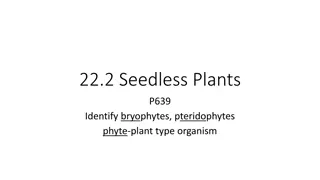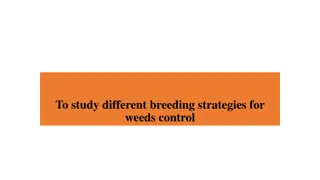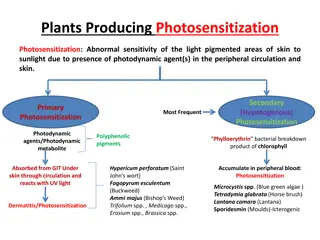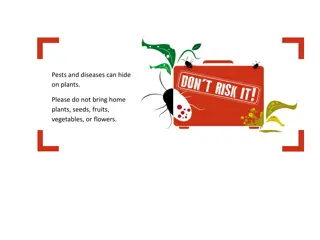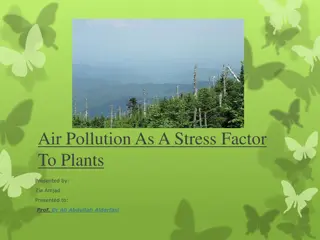Understanding Allelopathy in Plants: History, Effects, and Significance
Allelopathy, the phenomenon of one plant affecting another through the release of chemicals, has a rich history dating back to ancient times. This article explores the origins of allelopathy, its role in plant interactions, types of allelochemicals, and their impact on plant growth and competition. Understanding allelopathy is crucial for managing plant communities and optimizing agricultural practices.
Download Presentation

Please find below an Image/Link to download the presentation.
The content on the website is provided AS IS for your information and personal use only. It may not be sold, licensed, or shared on other websites without obtaining consent from the author. Download presentation by click this link. If you encounter any issues during the download, it is possible that the publisher has removed the file from their server.
E N D
Presentation Transcript
PRESENTED BY: N. ROMEN SINGH M.Sc.(hons.)final year,2011-2012 ROLL NO:15
1.INTRODUCTION 2.HISTORY 3.PLANT ALLELOCHEMICALS 4.ALGAL ALLELOPATHY 5.ALLELOPATHY OF BRYOPHYTES 6.ALLELOPATHY OF PTERIDOPHYTES 7.ALLELOPATHY OF GYMNOSPRMS 8.MODE OF ALLELOCHEMICAL INDUCTION 9.ALLELOPATHIC INTERACTION AMONG PLANTS 10. MODE OF ACTION OF PLANT INHIBITION 11.ROLES OF ALLELOPATHY IN NATURE 12.ADVANTAGES OF ALLELOCHEMICALS 13.CONCLUSION
The term Allelopathy, from the Greek-derived compounds allelo- and -pathy (meaning "mutual harm" or "suffering"), was first used in 1937 by the Austrian professor Hans Molisch in the book Der Einfluss einer Pflanze auf die andere - Allelopathie (The Effect of Plants on Each Other) published in German. Allelopathy refers to the beneficial or harmful effects of one plant on another plant, both crop and weed species, by the release of chemicals from plant parts .
Theophrastus (ca. 300 B.C.E.), a student and successor to Aristotle, wrote about allelopathic reactions in his botanical works. He has been called the "father of Botany", and wrote of how chickpea "exhausts" the soil and destroys weeds. In 1 C.E., Gaius Plinius Secundus, also known as Pliny the Elder, a roman scholar and naturalist, wrote about how chick pea and barley "scorch up" cornland. He also mentioned that Walnut trees are toxic to other plants. Augustin Pyramus De Candolle, a botanist and naturalist, in 1832, suggested that soil sickness was caused by chemicals released by the crop.
. Allelochemicals are a subset of secondary metabolites,[which are not required for metabolism (i.e. growth, development and reproduction) of the allelopathic organism. Allelochemicals with negative allelopathic effects are an important part of plant defense against herbivory Allelopathic chemicals can be present in any part of the plant. They can be found in roots, rhizomes,leaves,stems, flowers ,pollens, fruits, or seeds. They can also be found in the surrounding soil. Target species are affected by these toxins in many different ways.
These allelochemicals may be conveniently grouped as follows: GLUCOSIDES SAPONINS TANNINS ISOTHIOCYANATES GLUCOSINOLATES ALKALOIDS PHENOLIC COMPOUNDS ESSENTIAL OILS(sesquiterpenes ,terpenes,coumarins etc.) ORGANIC ACIDS and OTHERS. Their occurrence is sporadic but may be specific for FAMILIES,SUB FAMILIES and GENERA and sometimes even for SPECIES or SUB SPECIES
Alkaloids include literally thousands of bitter, nitrogenous compounds found throughout the plant kingdom. They often contain one or more rings of carbon atoms, with a nitrogen atom in the ring.
Organic acids Organic compounds having functional group COOH behave like acids and hence they are known as organic acids. For example:
All phenylpropanoids are derived from cinnamic acid, which is formed from phenylalanine by the catalytic action of phenylalanine ammonia- lyase (PAL), the branch point enzyme between primary (shikimate pathway) and secondary (phenylpropanoid) metabolism (Figure 2). It is known that many phenolic compounds not only have a physiologically functional ability, but also plant allelopathic potential. Figure.1. Scheme of phenylpropanoid pathway
Freshwater cyanobacteria produce several bioactive secondary metabolites with diverse chemical structure, which may achieve high concentrations in the aquatic medium when cyanobacterial blooms occur. Some of the compounds released by cyanobacteria have allelopathic properties, influencing the biological processes of other phytoplankton or aquatic plants. Fig: algal allelochemical affecting bacterial biodiversity
Mahoe whitey wood. Melicytus ramiflorus Water-soluble leachates (1%, 5%, 10% concentration) derived from 18 species of bryophytes (mosses 11 species; liverworts 7 species) were tested on the germination and seedling growth of Lactuca sativa and two common trees Melicytus ramiflorus (Violaceae) and Fuchsia excorticata(Onagraceae
Recent advances in fern allelopathy were introduced, including studies on the autotoxicity of ferns and of allelopathic interactions occurring in 2 ways (sporophytes acting on gametophytes and gametophytes acting on gametophytes). Fern autotoxicity is a type of intraspecific allelopathy, whereby a fern species inhibits the growth of its own kind through the release of toxic chemicals into the environment
Most of the studies pertaining to the sparse and reduced vegetations under the Conifers are due to the phytotoxins/alleloche mical,released by fallen litter layer(which forms the humus layer on the forest floor.
These molecules can be released by raindrops or condensing fog from the aerial parts of the emitter of the plant (this being very effective if the molecules are water soluble) WOUNDING, ATTACK BY PATHOGENS AND HERBIVORES or can be released into a hot dry atmosphere if metabolites are volatile (as with many terpenoids) In some plants, these
1.Inhibition of cell division in Root meristem 2.Inhibition of oxidation of plant hormones 3.Alteration of membrane permeability 4.Reduced stomatal aperture leading to the impaired photosynthesis 5.Interference with mitochondrial function . 6.Reduced protein synthesis 7.Clogging of the xylem strand leading to the impaired water balance.
Figure. Plants give off a variety of allelochemicals that can directly inhibit or stimulate the growth of other plants (allelopathy) and/or influence microorganisms in their own root zone (rhizosphere), in the bulk soil, or in other plants' rhizospheres. Similarly, soil and root zone microorganisms give off substances that can either support or hinder nutrient uptake and growth of plants. As a result, crops, weeds, and soil microbes are linked through a web of chemical and microbiological communications that can be quite species-specific
Chemical-mediated plant-plant interference, or allelopathy is one mechanism by which plants may gain an advantage over their competitors. Plants that produce and release potent phytotoxins can reduce the establishment, growth, or survival of susceptible plant neighbors, thus reducing competition and increasing resource availability. (
Plants that cause deleterious effects to another plant that is intentionally grown, or crop, are called weeds. 1.Golden rod 2.Black Locust, 3.Tree of Heaven, 4Garlic mustard . Allelopathic crops can be used to control weeds by: 1)Use of crop cultivars with allelopathic properties 2) Application of residues and straw of allelopathic crops as Mulches 3) Use of an allelopathic crop in a rotational sequence where the allelopathic crop can function as a smother crop or where residues are left to interfere with the weed population of the next crop
From the agronomic point of view, the research in allelopathy provides perspectives of a reduced reliance on traditional herbicides if weed control can be achieved by the release of allelochemicals from the crops. Also, in cropping systems where herbicides are not used, for example in organic farming, crop cultivars with enhanced allelopathic activity could be part of the weed management strategy. Weed control mediated by allelopathy - either as natural herbicides or through the release of allelopathic compounds from a living crop cultivar or from plant residues - is often assumed to be advantageous for the environment compared to traditional herbicides
The allelochemicals are involved in the environmental complex of managed or natural ecosystems. Allelopathic compounds have been shown to play important roles in the determination of plant diversity, dominance, succession, and climax of natural vegetation and in the plant productivity of agroecosystems. Botany and the Plant Sciences - Click on Image for JPG rendition The incorporation of allelopathic substances into agricultural management may reduce the use of synthetic herbicides, fungicides, and insecticides and lessen environmental deterioration. After the deforestation of coniferous or hardwood forests, a pasture grass, kikuyu grass (Pennisetum clandestinum), was transplanted onto the land. Significant suppression of weed growth by the kikuyu grass was found; however, the growth of coniferous or hardwood plants was not suppressed but stimulated.
Abiotic agents: soil fertility,light intensity (22 C and27 C),atmospheric humidity,water and abiotic stress and precipitation etc. Biotic agents: Attack by pathogens and herbivores, over populations etc.
The science of plant allelopathy exhibits complexities of biochemical interaction among plants including microbes. This plays an important role in agro-ecosystem leading to the healthy natural resources.These natural products (allelochemicals) are environmental friendly and target oriented.These biochemical products are originally plant secondary metabolites.
Allelopathy in Agroecosystems ,BY R.K. Kohli,Batish,Daizy Plant-Plant Allelopathic interaction ,BY Springer Plant Ecology BY Michael .J.Crawling ^ ab Stamp, Nancy (March 2003), "Out of the quagmire of plant defense hypotheses", The Quarterly Review of Biology78 (1): 23 55, Kruse, M. M. Strandberg and B. Strandberg. 2000. Ecological Effects of Allelopathic Plants - A Review. National Environmental Research Institute - NERI Technical Report No. 315. Silkeborg, Denmark. Rizvi, S. J. H., M. Tahir, V. Rizvi, R. K. Kohli, and A. Ansari. 1999. Allelopathic Interactions in Agroforestry Systems. Critical Reviews in Plant Sciences 18: 773-779. Altieri, M. 1993. Crop protection strategies for subsistence farmers. Westview Press, Achhireddy N.R. and Singh M. 1984. Allelopathic effects of lantana (Lantana camara) on milkweedvine (Morrenia odorata). Weed Sci. 32, 757 761. Blum U. 1998. Effects of microbial utilization of phenolic acids and their phenolic acid breakdown products on allelopathic interactions. J. Chem. Ecol. 24, 685 708. www.organicweeds.org.uk








